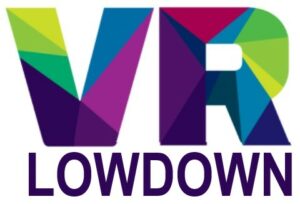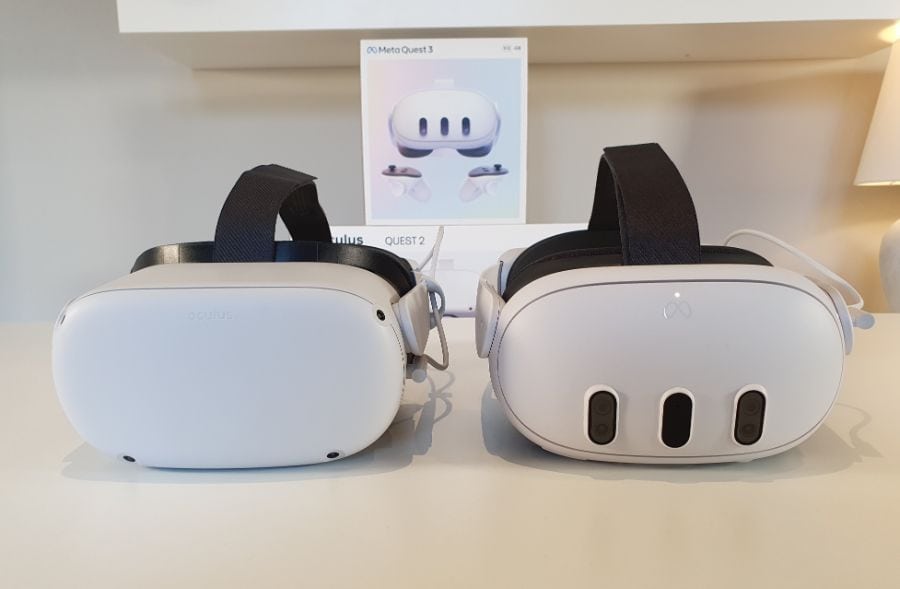
In the rapidly evolving world of virtual reality, making a decision about which headset to purchase can be as immersive as the experience itself. Whilst Meta Quest 3 is superior to Quest 2 in terms of hardware specifications, it comes with a heftier price tag. Does its technological prowess justify the investment for newcomers, and is it a worthwhile upgrade for current Quest 2 enthusiasts?
Whether you’re about to embark on your first VR journey or standing at the crossroads of upgrading, this article aims to provide you with all the necessary information to make a decision that’s right for you.
The Bottom Line
The Meta Quest 3 was released in October 2023 and comes with big upgrades in most areas compared to the Meta Quest 2. It has better lenses, display panels, and field of view (FOV). It has about twice the processing power of the Quest 2 and integrates fairly impressive mixed reality capabilities.
If you’re looking for the best standalone VR headset available today, Meta Quest 3 is the clear winner, and it should be top of your list to consider. I can confidently recommend the Meta Quest 3 to most people who are looking to get their first VR headset, as long as you are willing to spend $500+ for the experience.
However, both the Quest 2 and Quest 3 are able to play the same VR games, and except for the MR functionality, can do most of the same things. You can buy a brand new 128 GB Meta Quest 2 for $250 (£250) or a second-hand one for around $200, compared to the 128GB Quest 3 which currently costs $500 (£479.99). All of a sudden, the decision doesn’t seem as easy.
The Quest 2 was released in October 2020 and I’ve used it extensively since then. It’s a great headset and the content library available on the Meta store is extensive. Although the technology has now been superseded, Meta has no plans to stop supporting Meta Quest 2, and with an enormous install base of somewhere in the region of 20 million headsets, it’s likely to get new content, and full support for at least a few years to come.
If you’re looking to try VR for the first time without too much financial commitment, the Quest 2 sounds like a good option. You can play all of the same VR games as the Quest 3, admittedly with reduced graphical fidelity. Mixed reality is severely limited on Quest 2 in view of the low-quality grayscale passthrough cameras on the Quest 2, but as long as you are happy to forgo this feature, then Quest 2 has a lot to offer.
Despite the attractions and undoubtedly good value of the Quest 2, you should hesitate before buying it. The technology is three years old and is only going to get more outdated over time. The lenses and displays look poor in comparison to Quest 3, and the FOV is much more restricting. Three years ago, it was the best standalone headset you could buy. Now, it’s been superseded by Quest 3 and a number of other standalone VR headsets such as Pico 4.
Most people will be better served by holding off until they are in a position to buy a Meta Quest 3, or waiting for even better headsets in the near future. I appreciate that finances are a major factor in the decision, but I really think it is better to hold off getting any VR headset, rather than choosing one that is obsolete.
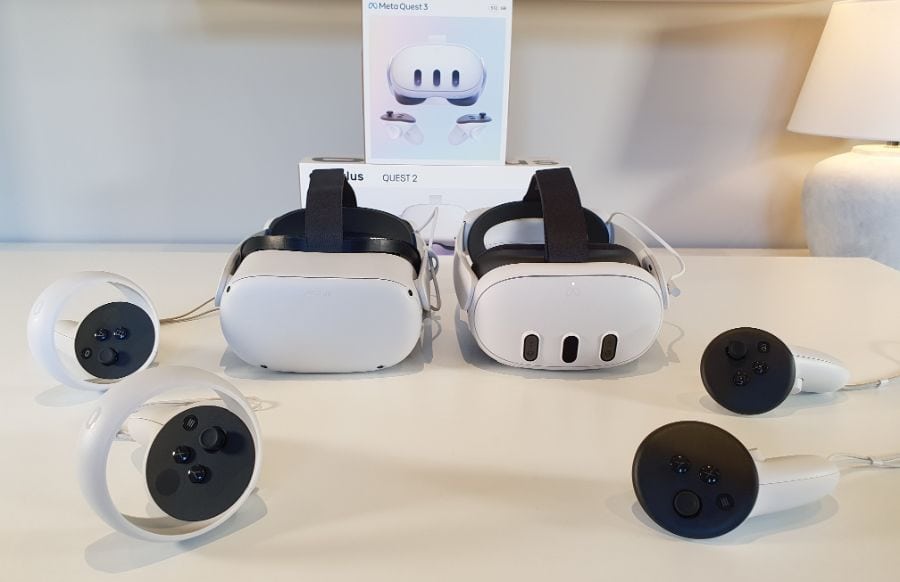
Why You Shouldn’t Buy Meta Quest 2
The journey towards creating a viable standalone headset has been a long one and Meta Quest 2 was the first headset where the hardware limitations didn’t negatively impact the experience too much. The resolution, lenses, field of view, controller tracking, and refresh rate were sufficiently good so that you could enjoy games without the technology getting in the way.
However, in the three-year gap between the launch of Quest 2 and the launch of Quest 3, there has been huge progress in many of the component technologies, resulting in Quest 3 being a significantly superior headset.
As with any rapidly developing technology, the jump between generations is huge. We saw this in the first few years of smartphones, where each generation was a big advancement over the last, and you really saw the benefits of a new phone. It was the same with games consoles, TVs, and computers, but as the technology matures, the jump between each new model gets smaller and smaller.
With the move from Quest 2 to Quest 3, we again see this big jump in the experience for users, that leaves the older technology looking really obsolete.
When I first became interested in VR about 10 years ago, I had the option to try the GearVR or Google Cardboard, but I didn’t want my first experience to be substandard, so I held off buying a VR headset until I could afford a VR-ready PC and a decent PC VR headset. The wait was totally worth it.
Despite saying all this, if you just can’t wait to try VR and can’t justify or afford the expense of a Quest 3, there is some merit in buying a Quest 2 for $250, or even a secondhand model for $200. You could always use it for 6-12 months and if you really enjoy it, sell and upgrade.
I know several people who purchased a Meta Quest 2 in the run-up to the release of the Quest 3, and they’re more than happy with their choices, but I would encourage you to consider the options carefully.
Should You Upgrade To Quest 3 From Quest 2?
For those of you who already own a Meta Quest 2 and are considering an upgrade to Quest 3, the decision is more nuanced. The visuals are a big step up from Quest 2, and the mixed-reality content is extremely impressive, but is it really worth buying another VR headset when you already own one?
If money is no object and you’re as enthusiastic about VR and MR as I am, it’s an easy decision – go and get a Quest 3, it’s so much better and you won’t regret the upgrade. However, Quest 3 is an evolutionary improvement compared to Quest 2, and if finances are tight, you may be better off sticking with what you have for now. You also need to factor in that you may want to get a new head strap, to upgrade from the inadequate default head strap, which will add to the cost.
Meta Quest 3 Vs Meta Quest 2 Video
In addition to this article, I’ve also made a video where I share my thoughts on the pros and cons of the Meta Quest 3 and Meta Quest 2. I explain exactly why the vast majority of people would be better off choosing Quest 3 over Quest 2, even though Quest 2 is half the price of Quest 3.
Meta Quest 3 Vs Quest 2 Specifications
Let’s move on to discuss some of the individual features of Meta Quest 3 and how they compare with Quest 2.
| Quest 3 | Quest 2 | |
| Launch | October 10, 2023 | October 13, 2020 |
| Lens Type | Pancake | Fresnel |
| Field of View | 110° horizontal, 96° vertical | 97° horizontal, 93° vertical |
| IPD Range | 53–75mm | 58-68mm (58, 63, 68mm fixed presets) |
| Depth Adjustment | Yes | No |
| Display Type | Dual LCD | Single LCD |
| Pixels Per Eye | 2064×2208 per eye | 1832×1920 per-eye |
| Pixels Per Degree (PPD) | 25 PPD | 20 PPD |
| Local Dimming | No | No |
| Max Refresh Rate | 120Hz (experimental) | 120Hz |
| Chipset | Snapdragon XR2 Gen 2 (4nm) | Snapdragon XR2 Gen 1 (7nm) |
| RAM | 8GB | 6GB |
| 6GHz Wi-Fi | Yes | No |
| Passthrough | True Color High Res | Greyscale Low Res |
| Battery Location | Visor | Visor |
| Battery Life | 2.2 hours (average) | 2 hours |
| Eye Tracking | No | No |
| Face Tracking | No | No |
| Controllers | Touch Plus Ringless TruTouch Haptics | Touch Tracking Rings Basic Haptics |
Visuals
The visuals of Quest 2 are good enough that they don’t get in the way of your enjoyment when playing games, but they’re not really good enough to make watching movies, reading text, and being productive in VR an enjoyable experience. The Quest 3 has improvements in the lenses, displays, FOV, and resolution that allow you to comfortably read text, watch movies, and enjoy activities in VR that require good visual clarity. Let’s look at the features that make the big differences in the visual clarity of these headsets.
Lenses
The Quest 2 uses fresnel lenses, which were impressive when they were released, but they suffer from a number of drawbacks compared to the pancake lenses of the Quest 3. They have a much smaller sweet spot, resulting in visuals that only provide good clarity when looking in the center of the lenses, and reduced visual clarity as you move your eyes to the periphery of your vision. In addition, the ridges of the fresnel lenses result in god-rays that are noticeable when viewing bright objects on a dark background.
In contrast, Quest 3 uses Pancake lenses, which provide a huge jump in visual clarity across your entire field of view and they don’t suffer with god-rays due to the lack of ridges in the lenses. Pancake lenses have only started to be used widely in consumer VR headsets due to them requiring very bright displays to counter the fact that up to 90% of the light passing through the lens is lost. Thankfully, display technology is at a point where this limitation can be mitigated sufficiently, and the difference in the visual clarity that this provides is incredible.
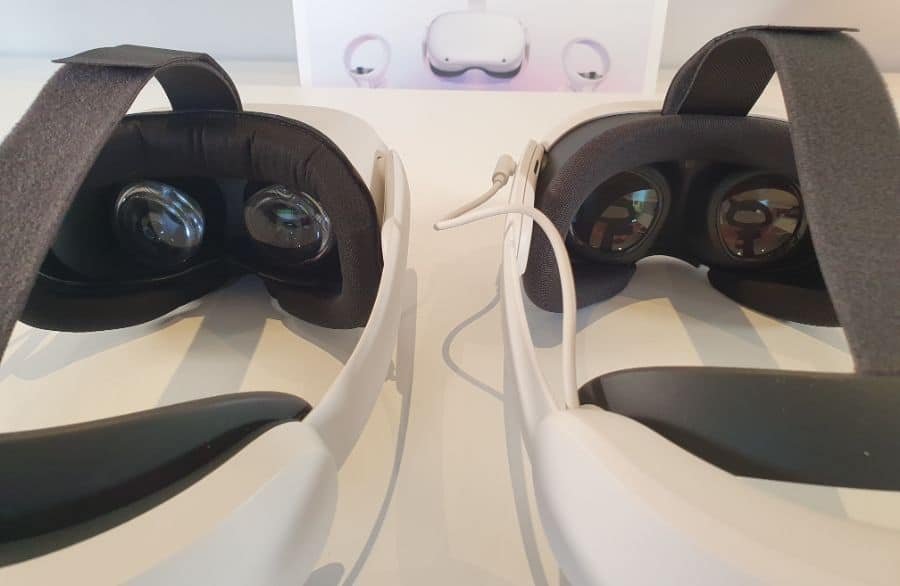
FOV
The Quest 2 has a field of view (FOV) of 97° horizontally, and 93° vertically compared to the Quest 3 which has an FOV of 110° horizontally, and 96° vertically. These figures are approximate and will vary slightly depending on how close the lenses are to your eyes and the individual anatomy of your face.
Whilst it might seem like a fairly minor increase in FOV, the extra 13° horizontal FOV makes a big difference. Many people describe wearing a VR headset as like looking through a diving mask, with your peripheral vision cut off. The Quest 2 still feels like this, but the Quest 3 feels much less limited in this regard. You can still see the edges of the FOV in the peripheries of your horizontal and vertical vision, but it is much more subtle and less intrusive.
Display Panels
The Quest 2 uses a single display panel with a resolution of 1832×1920 per eye compared to the Quest 3, which uses two display panels, each with a resolution of 2064×2208 per eye. Although there doesn’t seem to be that much difference in resolution, due to the Quest 2 using only one display panel, it can’t display all of the pixels at the same time, so the effective resolution is somewhat lower than the resolution of the display panel, resulting in about a 30% increase in the number of displayed pixels on Quest 3.
This results in a big jump in visual clarity, enabling you to see small features more clearly, read text with ease, and minimize pixelation. The visual clarity of VR headsets is often measured in Pixels Per Degree (PPD), meaning the number of pixels per degree of horizontal FOV. Quest 2 has 20 PPD and Quest 3 has about 25 PPD, providing a big jump in clarity.
However, for anyone expecting perfection, you need to be aware that you need about 60 PPD to achieve the same resolution as the human eye, so there is still a long way to go before VR headsets achieve this lofty goal.
Processing Power
The final thing that makes a huge difference to the visuals is the upgrade in processing power that the Quest 3 enjoys over the Quest 2. The Quest 2 uses a Qualcomm Snapdragon XR2 Gen 1 processor, whereas the Quest 3 uses the Snapdragon XR2 Gen 2 processor. Whilst these may sound similar, the Gen 2 processor has about twice the processing power of the Gen 1, and this shows dramatically in a wide range of games and experiences that have received graphical boosts to make use of the Quest 3 hardware.
All of these improvements combine to produce visuals that are head and shoulders ahead of Quest 2. If you own a Quest 2, I would strongly encourage you not to try a Quest 3, as you will forever ruin your enjoyment of Quest 2. Every time I go back to my Quest 2, I am struck by how much worse the visuals are, and I never stick it for long before willingly going back to my Quest 3.
Form Factor And Comfort
The Quest 3 is about 40% slimmer than the Quest 2 but is actually very slightly heavier. However, with the slimmer profile, the headset sits closer to your face, so feels lighter, and more comfortable to wear. It shifts on your face less when you move thanks to the reduced leverage, making a range of high-tempo games much more comfortable to use.
The default head straps of both the Quest 2 and Quest 3 are woefully inadequate, and neither support the headsets well nor provide much comfort. If you enjoy using either of these headsets, you will want to get a suitable rigid head strap, either the official Meta Elite Strap or a suitable third-party strap.
The default Quest 3 strap is slightly better than the Quest 2 strap, but I still switched mine out at the first opportunity, so this isn’t exactly a win for the Quest 3.
The Quest 3 looks better and is more comfortable to wear overall. It’s not a huge difference, but Meta has clearly put time and effort into making improvements for the Meta Quest 3.
You may be wondering why Meta doesn’t include a better head strap by default with either of these headsets, and I think it clearly comes down to the cost of manufacture and the target sales price. It’s been well documented that Meta is selling their Quest 3 at or below manufacturing cost, and this was the same when the Quest 2 was launched.
Meta is also aware that most people tend to use their headsets for periods of less than an hour at a time, and they have made the decision that the cheaper fabric strap is adequate for shorter bursts and keeps the cost down. I can’t argue with the logic, but still feel disappointed that a lot of people will have a moderately uncomfortable first experience of VR.
If I was Meta, I would dig deeper in my pockets to ensure that users of Quest 2 and Quest 3 become the superfans that they need to grow the VR market.
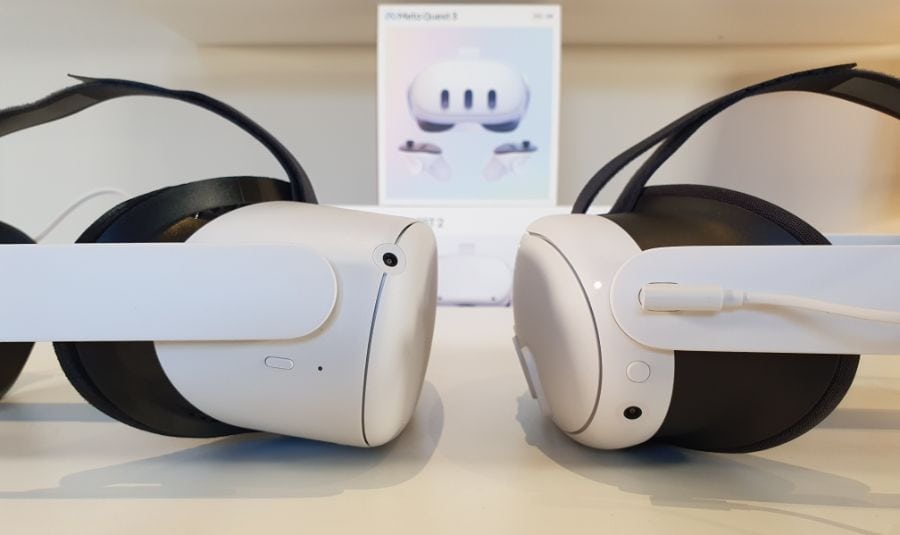
Games And Mixed Reality
Quest 3 has no exclusive VR games, meaning that both Quest 2 and Quest 3 can play all of the same VR content. Thanks to several years of consistent game and app releases, the amount of content is really quite impressive, and easily the most comprehensive library of standalone VR content.
Many games have received a graphical upgrade for Quest 3, and this is very noticeable and impressive, thanks to the more powerful XR2 chip in the Quest 3. Games like The Walking Dead: Saints and Sinners, and Golf+ look so much better on Quest 3. Others have received more modest graphical upgrades.
The improved resolution also makes a big difference to the amount of pixelation you see when looking at distant objects, and this has as much or more impact on the quality of the visuals. Whilst the graphics on Quest 3 still don’t compare to a lot of PC VR titles, they are a big jump up, and make the Quest 2 graphics look old and dated in comparison.
Mixed reality content is largely exclusive to Quest 3, due to the much better passthrough capabilities. The Quest 3 has two high-res passthrough cameras and a depth sensor, enabling some highly impressive mixed-reality games. Quest 2 has two grayscale passthrough cameras which can be used to play some mixed reality content, but the experience feels very experimental in nature.
I wasn’t particularly enthusiastic about mixed reality prior to getting Quest 3, but I’ve been really impressed by the capabilities. It has allowed me to play games like Eleven Table Tennis, where I can place the table in my hall and play table tennis in my home while retaining full awareness of my surroundings. It’s the same for games like Thrill of The Fight, where I’d previously been apprehensive about punching a wall, but MR allows me to see exactly where I am in the real world.
One of the most impressive Quest 3 mixed reality experiences that I have tried so far is PianoVision, which is an app that helps you to learn the piano, by placing a virtual keyboard over your real piano. This then shows you what notes to play and when, and incorporates loads of features to help you learn piano in mixed reality. You can read my review of this app and watch my video review for more info.
The technology to provide high-quality mixed reality experiences has only just reached an acceptable level with the launch of the Quest 3, and it has got me very excited about what the future of this technology will bring.
Pricing: Quest 3 Vs Quest 2
Although Quest 2 has seen a price cut following the launch of Quest 3 and is available for as little as $250 right now, I still don’t think this is a good option for most people. Either you will be put off by the relatively inferior technology, or you will love it and invest in accessories that are unlikely to be compatible with a future upgrade. If you end up liking and enjoying VR, then I reckon buying a Quest 2 will end up costing you more money in the long run.
I do appreciate that Quest 3 is basically twice the price, but Meta is still selling it at a loss, and it’s about the same price as a mid-range phone, so it’s hard to describe it as being overpriced. If money is an issue, I would urge you not to waste it getting a Quest 2. If you really want to try VR, then it would be better to save up for a Quest 3 or a future headset and enjoy all that current VR headset technology can offer.
Even if you end up getting a headset and deciding that VR isn’t for you, you should be able to sell a nearly new headset for only a little less than you paid for it.
